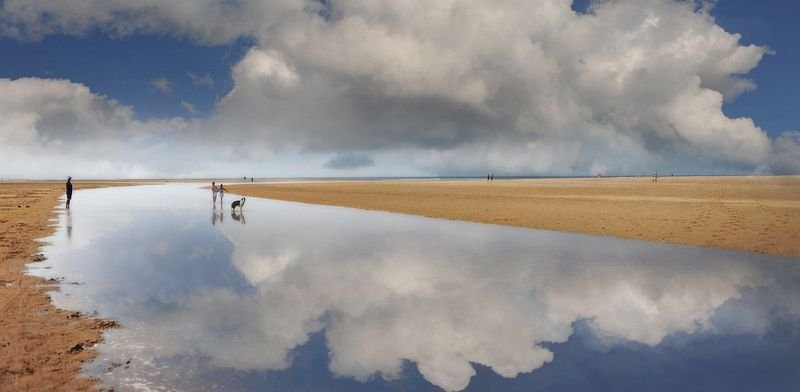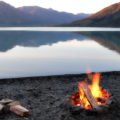
There is no anti-depressant quite like sea-swimming, and Holkham is where I usually go when I’m feeling sad. Striking out into the enormous expanse of cold sea, over the vast sands, I immerse myself like the fox ridding himself of his fleas. I leave my devils on the waves. North Norfolk is one of those places where the weather never seems to bear any relation to the forecasts. The whole of Britain can be covered in cloud, yet as you approach the coast up here, it is braided with a magic band of blue. The Royal Family must have known a thing or two when they chose Sandringham as a country cottage.
You arrive at Holkham beach as you would at Glyndebourne, Epidaurus or Newmarket races; there is a sense of occasion, as befits a visit to one of our most impressive stretches of wild coastline. Opposite the entrance to the Holkham estate you turn into a dramatic wide boulevard of poplars called Lady Anne’s Walk and pay the Viscount Coke’s amiable gatekeepers a modest sum to park. We felt we should be showing our passports. Even at this hour there were a couple of parked horseboxes with the ramps down, and a few Volvos with ‘A dog is for life not just for Christmas’ stickers in the back. This elegant cul-de-sac leads half a mile across the grazing marshes to a narrow gap in the Holkham Meals, the strip of mixed pine and holm-oak wood that runs along the dunes west to Burnham Overy Staithe and east to Wells.
Dudley and I set off barefoot over the sandy boardwalk through the wooded dunes and emerged blinking from the shade into the great gleaming theatre of Holkham Bay. A majestic sweep of dunes delineates an endless beach where, at low tide, the sea is only a distant whispering line of white. In the middle of all this are a couple of piratical sand islands that get cut off by the tide and are popular with lovers and picnic parties. Further west towards Burnham the dunes rise into a whale-back ridge reminiscent of the Malverns. There used to be the rusty hulk of an early Austin almost completely buried in the sand, but now I suppose it has sunk for ever, or dissolved. Coming along below the dunes was a string of twenty racehorses and their lads, returning to the horseboxes. It is the sort of thing you expect to see in Ireland, but there are often hoof-prints in the Holkham sand, and you can gallop for miles beside the sea.
We made for the surf across the almost deserted beach and half-waded, half-walked into the sun towards Scolt Head and Burnham Overy Staithe. One of the great joys of Holkham beach is to swim in the lagoons that appear in the sands as the tide goes out. Most are only just deep enough for a wallow, but some are up to four feet deep in places. They can be very warm, and I once stepped on a Dover sole in one. Miles from anywhere, we came upon a waterhole that was especially long and deep, and splashed about in it like two desert travellers in an oasis. Watching the little waves criss-crossing and buffeting each other, Dudley remembered how, as a boy learning to sail in Canada, he would study why this or that current behaved the way it did, or why there was a deep channel in the sand here but not there. Standing knee-deep in the sea and feeling it tug this way and that before we plunged out into deeper water, we agreed that these are indeed serious questions. Swimming into the sun, we struck out against the current. Our coast is being altered by the sea at every tide, and every storm, and nowhere more than here on the east coast. Back there on the beach I had searched for a whale jaw the size of an armchair that was stuck fast in the sand last winter, but was buried now, or washed away. Holkham is compulsive beach-combing. Razor shells are strewn everywhere like bones in a Mad Max film, and the delicate, finely perforated shells of sea urchins are beached like tattooed bums or paper masks.
Three miles on, by the entrance to Burnham Harbour, opposite Scolt Head Island, the channel buzzed with dinghies going in and out. Boats were pulled up on the beaches, and families picnicked in the dunes. I swam alone across to the island and back, dodging the Lasers and Enterprises. I felt the vigorous tug of the tide, and crossed the channel diagonally. If Nelson ever bathed, this would surely have been one of his haunts, close to his native Burnham Thorpe. But it was the policy of the navy to discourage and even forbid sailors to swim. Traditionally, few fishermen were swimmers either, the idea being that if you are going to drown in a shipwreck it is better not to prolong the agony.
We followed the path through Overy Marsh towards Burnham, passing two houseboats moored under Gun Hill. One was based on Noah’s original drawings for the ark, with a single window facing west across the marsh. It bore a notice: ‘This ark is used by a local artist as a simple working space. You are welcome to see inside when he is here. The only item of value inside is the Vieuw.’ From the spelling, we deduced that Noah was Dutch. I could think of worse places to be stranded in the Flood.
A butterfly went past over the sea lavender. I said it was a swallowtail. Dudley thought it was a cabbage white. ‘That’s the difference between us,’ he said. I kept my eyes firmly on the sandy path ahead, hoping to find a lizard out sunbathing. Dudley would probably think it was a stick, but I would know it was a lizard. We were, after all, in one of English Nature’s prime reserves. There have been attempts to reintroduce the sand lizard here, but they have an uncooperative way of eating their own young. These dunes are also home to the natterjack toad, who likes to dig himself as much as a foot into the sand in the daytime, emerging at night to roam the flotsam line of the beach, hungrily rummaging the dead seaweed for the Assiette de Fruits de Mer of small creatures it contains.
Swimming into Burnham Overy Staithe on the mud-warmed rising tide, we entered a time warp. Sailing people sat about amongst the dinghies with picnic baskets and those Acme Thermos flasks finished in pale green Hammerite that weigh about the same as a milk churn. A woman in rust canvas shorts and plimsolls, with masses of fair curls like Titty in Swallows and Amazons, was fishing lifejackets out of a Land-Rover Discovery. She told us that the channel through which we had just swum was known affectionately to the locals as Dead Man’s Pool. They have a way with metaphor in Burnham, always seeing in the New Year round a bonfire of old boats.
A friend who has spent her springs and summers in Burnham Overy Staithe all her life, once told me, ‘I can trace the creeks in the lines of my own hand.’ We walked back towards Holkham, navigating through waves of sea lavender on the saltmarsh mud, crazed and frosted with salt, until we reached the dunes again and ascended Gun Hill, where I spotted a common lizard sunbathing obligingly before a clump of marram grass. The view into the hazy distance of this great sweep of utterly wild coast silenced us both for some time. Three miles inland we could make out the elegant wooded landscaping of Holkham Park, with its landmark obelisk and the fine house well sheltered from the sea, looking out instead over a lake. Holm oaks are the distinctive local tree here, planted all over the estate by the pioneering agriculturalist Coke in the eighteenth century. According to one of the Holkham Hall gardeners, the trees first arrived as acorns in a consignment of china from Italy. They had been used as a kind of eighteenth-century bubblewrap, and Coke told his men to fill their pockets with acorns in the mornings and plant them all round the estate. Until Thomas Coke built Holkham Hall in the middle of the eighteenth century, there had been almost no trees here at all, but, as the historian David Dymond discovered, no fewer than 2,123,090 trees were planted on about 720 acres of the park in the twenty years from 1781. It is interesting that although the holm oaks and Scots pines, all planted by Coke, form a useful evergreen screen against the cold winds blowing in across the North Sea straight from the Ural Mountains of Russia, they also hide it from view. It is only relatively recently that we have come to regard a view of the sea as a thing of beauty. For our ancestors, the sea was to be feared and shunned from sight. When Humphry Repton designed Sheringham Hall, or ‘Bower’, further along this coast, in 1812, he positioned it facing east of south, away from the sea, only three-quarters of a mile away. He thought that ‘A view of the sea . . . ought not to be the first consideration.’
A little further on, we were greeted by a sign, courtesy of English Nature, informing us that ‘Naturists are requested to keep to the beach. Naturism is not permitted in the woods, or outside designated areas within the dunes.’ Curious about the ‘designated areas’, Dudley and I headed straight off in search of them.






